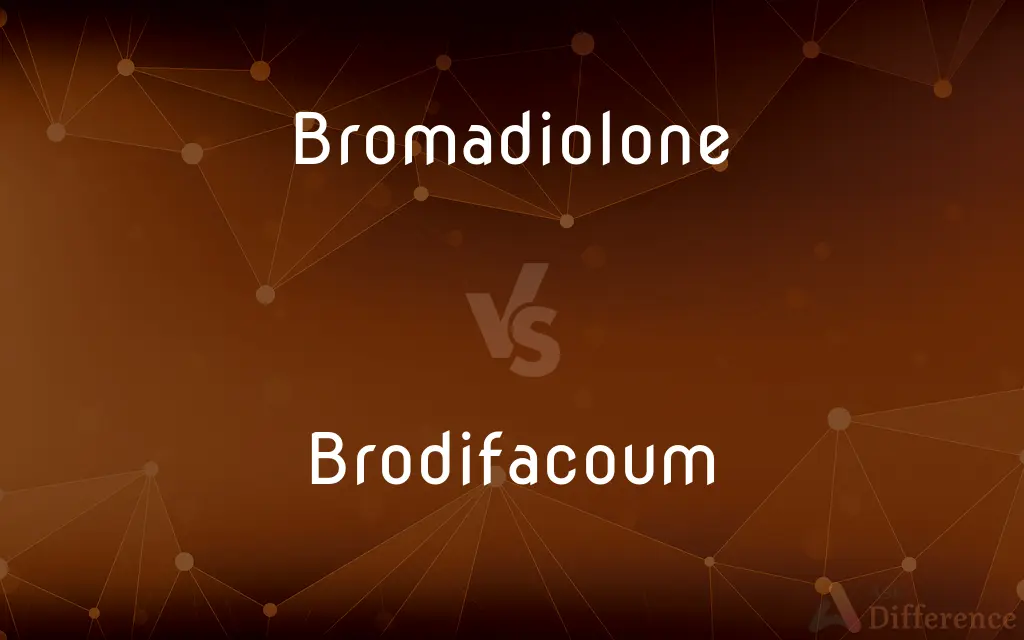Bromadiolone vs. Brodifacoum — What's the Difference?
By Tayyaba Rehman & Urooj Arif — Updated on April 7, 2024
Bromadiolone is a second-generation anticoagulant rodenticide requiring multiple feedings to be effective, while brodifacoum is more potent, often requiring only a single ingestion.

Difference Between Bromadiolone and Brodifacoum
Table of Contents
ADVERTISEMENT
Key Differences
Bromadiolone, developed in the 1970s, is a second-generation anticoagulant rodenticide designed to control populations of rats and mice resistant to first-generation anticoagulants. It works by inhibiting the vitamin K cycle, leading to fatal hemorrhaging in rodents after multiple feedings over several days. This delayed effect allows for its undetected ingestion by other members of the rodent population. Whereas brodifacoum, also a second-generation anticoagulant, is known for its extremely high potency and long half-life in the body.
While bromadiolone is considered safer for use in environments where non-target species might be exposed, due to its somewhat lower toxicity and shorter persistence in the environment, brodifacoum is restricted to indoor use or around industrial and agricultural settings to mitigate environmental risks. Bromadiolone's moderate persistence means it poses less risk of secondary poisoning, where animals that eat poisoned rodents are affected.
Bromadiolone's effectiveness is seen over a period of several days to a week, allowing for the eradication of entire colonies through the social behavior of rodents sharing the bait. On the other hand, brodifacoum's ability to kill after a single dose can disrupt infestations more rapidly, but it may not exploit the social feeding habits of rodents as effectively as substances requiring multiple feedings.
The use of bromadiolone is generally recommended for less severe infestations or maintenance control, where its slower action and lower risk to non-target animals are advantageous. Brodifacoum, with its stronger and quicker action, is preferred for tackling severe or stubborn infestations, but it comes with increased regulatory restrictions due to its higher environmental and non-target species risks.
Regulatory bodies often categorize bromadiolone for broader use, including residential areas, given its safety profile compared to more potent poisons. Brodifacoum, however, is subject to tighter controls, typically reserved for professional pest control operators, reflecting its higher toxicity and the greater care needed to avoid unintended harm.
ADVERTISEMENT
Comparison Chart
Category
Second-generation anticoagulant
Second-generation anticoagulant
Efficacy
Requires multiple feedings
Often effective with a single ingestion
Toxicity to Humans and Pets
Moderately toxic; requires multiple doses for effect
Highly toxic; single ingestion can be lethal
Environmental Persistence
Moderate; less risk of secondary poisoning
High; greater risk of secondary poisoning
Usage Restrictions
Fewer; suitable for a broader range of environments
More; typically restricted to professional use
Compare with Definitions
Bromadiolone
Less risk of secondary poisoning compared to stronger poisons.
Bromadiolone is favored in residential areas due to its lower risk to pets and wildlife.
Brodifacoum
Restricted to professional use in many regions.
Only certified pest control operators can deploy brodifacoum due to its high toxicity.
Bromadiolone
A potent rodenticide used to control rat and mouse populations.
Bromadiolone bait stations were installed around the perimeter of the building to control the rodent problem.
Brodifacoum
Effective against severe rodent infestations.
For stubborn rat colonies, brodifacoum is the preferred choice.
Bromadiolone
Known for requiring multiple feedings to be effective.
The effectiveness of bromadiolone depends on repeated ingestion by rodents.
Brodifacoum
Second-generation anticoagulant with high environmental persistence.
Brodifacoum remains active in the ecosystem longer than other rodenticides.
Bromadiolone
Second-generation anticoagulant rodenticide.
As a second-generation anticoagulant, bromadiolone is more effective against resistant rodent populations.
Brodifacoum
Highly potent rodenticide capable of killing after a single dose.
Brodifacoum bait proved effective at quickly reducing the severe infestation.
Bromadiolone
Used in both agricultural and urban pest control strategies.
Bromadiolone is a key tool in our integrated pest management program.
Brodifacoum
Known for its long half-life and risk of secondary poisoning.
The use of brodifacoum is carefully monitored due to its environmental impact.
Bromadiolone
Bromadiolone is a potent anticoagulant rodenticide. It is a second-generation 4-hydroxycoumarin derivative and vitamin K antagonist, often called a "super-warfarin" for its added potency and tendency to accumulate in the liver of the poisoned organism.
Brodifacoum
Brodifacoum is a highly lethal 4-hydroxycoumarin vitamin K antagonist anticoagulant poison. In recent years, it has become one of the world's most widely used pesticides.
Bromadiolone
A potent rodenticide, a second-generation coumarin derivative.
Brodifacoum
(poison) A highly lethal anticoagulant poison used as a rodenticide.
Common Curiosities
Can bromadiolone and brodifacoum affect humans?
Yes, both can be toxic to humans if ingested, but brodifacoum poses a higher risk due to its potency.
Why is brodifacoum restricted to professional use?
Due to its high toxicity and the risks it poses to non-target species and the environment.
How are bromadiolone and brodifacoum used in pest control?
Bromadiolone is used for less severe infestations and maintenance, while brodifacoum is reserved for severe or stubborn infestations.
Which is more potent, bromadiolone or brodifacoum?
Brodifacoum is more potent, often requiring only a single ingestion to be lethal.
Are bromadiolone and brodifacoum safe for pets and wildlife?
Both pose risks, but bromadiolone is considered safer due to its lower toxicity and reduced risk of secondary poisoning.
How do bromadiolone and brodifacoum work?
They inhibit the vitamin K cycle, leading to fatal hemorrhaging in rodents.
What are bromadiolone and brodifacoum?
Both are second-generation anticoagulant rodenticides, with bromadiolone requiring multiple feedings for efficacy and brodifacoum being potent enough to work with a single dose.
How long do bromadiolone and brodifacoum remain active in the environment?
Brodifacoum has a longer environmental persistence than bromadiolone, leading to a higher risk of secondary poisoning.
What is the main difference in the application of bromadiolone and brodifacoum?
Bromadiolone is suitable for a broader range of environments, whereas brodifacoum is typically restricted to professional use due to its higher toxicity.
What makes second-generation anticoagulants like bromadiolone and brodifacoum different from first-generation?
They are more potent and effective against rodents resistant to first-generation anticoagulants.
Share Your Discovery

Previous Comparison
Failure vs. Collapse
Next Comparison
Governance vs. PolicyAuthor Spotlight
Written by
Tayyaba RehmanTayyaba Rehman is a distinguished writer, currently serving as a primary contributor to askdifference.com. As a researcher in semantics and etymology, Tayyaba's passion for the complexity of languages and their distinctions has found a perfect home on the platform. Tayyaba delves into the intricacies of language, distinguishing between commonly confused words and phrases, thereby providing clarity for readers worldwide.
Co-written by
Urooj ArifUrooj is a skilled content writer at Ask Difference, known for her exceptional ability to simplify complex topics into engaging and informative content. With a passion for research and a flair for clear, concise writing, she consistently delivers articles that resonate with our diverse audience.
















































